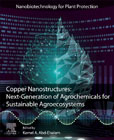
Copper Nanostructures: Next-Generation of Agrochemicals for Sustainable Agroecosystems
Abd-Elsalam, Kamel A.
Copper Nanostructures: Next-Generation of Agrochemicals for Sustainable Agroecosystems considers the impact of copper-based nanostructures on agri-food sectors. Sections highlight the green synthesis of copper nanoparticles, production mechanisms, eco-safety, and future perspectives, discuss the increasing importance of copper nanomaterials in plant protection applications, describe the use of copper nanostructures in plant science applications, cover antimicrobial applications, explore copper nanostructure applications, and summarize current applications in agroecosystems, such as copper nanoparticles as nanosensors, their negative ecological effects, estimation risks, and more. Assesses the impact of a large variety of copper-based nanostructures on the agri-food sector Discusses how the properties of a variety of copper-based nanomaterials make them effective for agricultural applications Explains the challenges surrounding the mass production of copper-based nanomaterials INDICE: 1 Copper-based nanomaterials: Next-generation agrochemicals: A note from the editor PART 1 Green synthesis 2 Green synthesis of copper-based nanoparticles using microbes 3 Biosynthesis and characterization methods of copper nanoparticles and their applications in the agricultural sector 4 Natural gums as a sustainable source for synthesizing copper nanoparticles 5 Role of processing parameters in solution routes for controlling size, shape, and morphology of chalcogenide nanoparticles PART 2 Plant protection 6 Copper-based nanopesticides 7 Cu and Cu-based nanomaterials as nanofungicides 8 Copper-based nanostructures for plant disease management 9 Cu-based nanoparticles as pesticides: Applications and mechanism of management of insect pests 10 Copper nanomaterials for pesticide detection 11 Copper nanomaterials for eliminating the risk of mycotoxins 12 Application of copper-based nanomaterials against parasitic nematodes PART 3 Plant science 13 Impact of copper-based nanoparticles on economically important plants 14 Copper-based nanoparticles in soil: Uptake, bioaccumulation, toxicity, and biotransformation in plants 15 Nanostructured materials based on copper/carbon as a plant growth stimulant 16 Applications of copper nanoparticles in plant protection and pollution sensing: Toward promoting sustainable agriculture PART 4 Antimicrobials 17 Biosynthesis and antibacterial activity of Cu and CuO nanoparticles against pathogenic microorganisms 18 Antimicrobial activity of copper nanomaterials: Current status and future perspectives 19 Copper-based nanostructures: Antimicrobial properties against agri-food pathogens PART 5 Veterinary applications 20 Copper nanoparticles: Synthesis, characterization, and its veterinary applications 21 Safety considerations of copper nanoparticles as food and feed additives PART 6 Agroecosystem applications 22 Cu-based nanomaterials for production of novel agrochemicals 23 Multifunctional copper-based nanocomposites in agroecosystem applications 24 Effect of copper-based nanoagrochemicals on plants and soil: A critical review 25 Understanding the effect of copper-based nanoagrochemicals on nitrogen-fixation ability of blue-green algae: A review 26 Advances in the applications of copper-based nanocomposites in wastewater treatment 27 Synthesis of copper nanostructures: Antimicrobial applications and environmental remediation of emerging agrochemicals 28 Copper-based metal-organic framework for environmental applications 29 Ecological effects of copper NPs: Advantages and drawbacks regarding current and potential applications 30 Copper nanoparticle-based sensors for environmental pollutions
- ISBN: 978-0-12-823833-2
- Editorial: Elsevier
- Encuadernacion: Rústica
- Páginas: 822
- Fecha Publicación: 19/01/2022
- Nº Volúmenes: 1
- Idioma: Inglés
